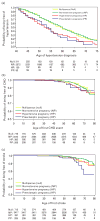Hypertension in pregnancy as a risk factor for cardiovascular disease later in life
- PMID: 20087214
- PMCID: PMC2980863
- DOI: 10.1097/HJH.0b013e328335c29a
Hypertension in pregnancy as a risk factor for cardiovascular disease later in life
Abstract
Objective: The association between hypertension in pregnancy and future cardiovascular disease (CVD) increasingly is recognized. We aimed to assess the role of hypertension in pregnancy as an independent risk factor for hypertension, coronary heart disease (CHD), and stroke later in life.
Methods: Women who participated in the Phase 2 (2000-2004) Family Blood Pressure Program study (n = 4782) were categorized into women with no history of pregnancy lasting more than 6 months (n = 718), women with no history of hypertension in pregnancy (n = 3421), and women with a history of hypertension in at least one pregnancy (n = 643). We used Kaplan-Meier and Cox proportional hazard models to estimate and contrast the risks of subsequent diagnoses of hypertension, CHD, and stroke among the groups.
Results: Women with a history of hypertension in pregnancy, compared with those without such a history, were at increased risks for the subsequent diagnoses of hypertension (50% hypertensive at the age 53 vs. 60, P < 0.001), CHD (14% estimated event rate vs. 11%, P = 0.009), and stroke (12% estimated event rate vs. 5%, P < 0.001). The increased risk for subsequent hypertension remained significant after controlling for race, family history of CVD, smoking, dyslipidemia, and diabetes mellitus, with an adjusted hazard ratio of 1.88 [95% confidence interval (CI) 1.49-2.39, P < 0.001]. After controlling for traditional risk factors, including subsequent hypertension, the increased risk for stroke remained statistically significant (hazard ratio 2.10, 95% CI 1.19-3.71, P = 0.01), but not for CHD.
Conclusion: Hypertension in pregnancy may be an independent risk factor for subsequent diagnoses of hypertension and stroke.
Conflict of interest statement
There are no conflicts of interest.
The following investigators are associated with the Family Blood Pressure Program:
National Heart, Lung, and Blood Institute: Dina Paltoo and Cashell E. Jaquish.
Figures

References
-
- . Report of the National High Blood Pressure Education Program Working Group on High Blood Pressure in Pregnancy [comment] Am J Obstet Gynecol. 2000;183:S1–S22. - PubMed
-
- Chesley SC, Annitto JE, Cosgrove RA. The remote prognosis of eclamptic women. Sixth periodic report. Am J Obstet Gynecol. 1976;124:446–459. - PubMed
-
- Lindeberg S, Axelsson O, Jorner U, Malmberg L, Sandstrom B. A prospective controlled five-year follow-up study of primiparas with gestational hypertension. Acta Obstet Gynecol Scand. 1988;67:605–609. - PubMed
-
- Selvaggi L, Loverro G, Schena FP, Manno C, Cagnazzo G. Long term follow-up of women with hypertension in pregnancy. Int J Gynaecol Obstet. 1988;27:45–49. - PubMed
Publication types
MeSH terms
Grants and funding
LinkOut - more resources
Full Text Sources
Other Literature Sources
Medical

